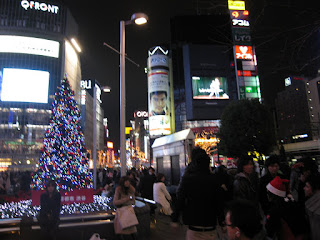At the end of May, a friend from Minnesota was in town. Heidi's visit was a great excuse to revisit those things that were at first quite novel and have since become regular ingredients in my life this year. A visit to the neighborhood izakaya, 居酒屋, for the island's local beer and some kimchi yakisoba and edamame (a popular and tasty soybean appetizer). A bus ride to the enormous aquarium housing whale sharks and manta rays and turtles and dolphins and an amazing botanical garden halfway up the island, Churaumi. Chura, beautiful in the old Okinawan dialect, and umi, ocean. Those, and other things. It was lovely to spend some time with her and also be reminded of the special things, be they Japanese, Okinawan, or just exactly what they are, that surround me while I live and work here.

A week and a half ago, I spent several days, along with one of my coworkers, preparing ten students chosen to attend the G8 Summit's Science and Technology Minister's meeting discussion of current Environmental Issues. After long days at school, sometimes exhilarating, sometimes draining, and usually with the first and second year students that I primarily work with this semester who are still trudging through early levels of English conversation ability, it was an enjoyable challenge to work through a topic of interest to me and some students I've known for many months now. Students who constantly try and ask and invest energy in growing and stumbling and making great advances in their journey of learning. With nerves, last Monday, we reviewed major topics and points of individual interests. Nao asked me, just before leaving, what I would ask if I were in her position. I was caught a bit off guard, but I said I'd inquire about the next plan of action. Of true motion toward change.
Several of the students came up to me on Tuesday, after attending the meeting, slightly disappointed but extremely thankful. They were proud to have been part of the “discussion” and happy to have become more aware of topics that they had only heard bits of, whether in their native language or English. Only two had the opportunity to ask questions and it was perhaps more of a practice in listening than discussion. There was much less participation on part of the students than they had hoped. While Nao and I were conversing about the results of the experience (she was one of the two students from our school who was allowed to ask questions), she said somewhat disappointedly, “I asked your question, Grace”, but she and the other students weren't particularly impressed with the response of their nation's minister. “What matters is what is in your heart” was the translation. Not moments later, I was talking to Arisa, who told me that this experience had made her even more sure that her minor in college will be Environmental Studies.
Amidst all this, I also took the opportunity to see the cliffs on the northern edge of the island during a rare two-day weekend. Cape Hedo on a cloudy day was perfect. The heat and humidity, the high and hot sun, which are inescapable at this time of year, were staved off for a a refreshingly less-hot (although I wouldn't say cool) weekend. Mushiatsui (humid-hot) has been the favorite word of many these days. Although a bike ride around the island would be ideal, time doesn't allow it at the moment. A friend and I rented a car and drove up the east side of the island on slow and winding roads. It was a strange feeling to be in control of my own motion on the road again. We stopped by a coffee farm and walked around the cliffs of Hedo, peering down to the aquamarine blue splashes below white crashing waves.

A splurge on a Japanese hotel (ryokan) was a very good choice (yay! public baths!). Although finding the road that climbed up Nikijin, a small mountain/big hill halfway down the west side of the island, was not easy, it was entirely worth it. As the little Toyota purred up the path, all we could see ahead of us was misty fog. By the time we made it to the top and exited the car, we were heading toward a ryokan in the clouds. After dropping my bag in our entryway and I walked through the small and comfortable tatami room to the big window facing the edge of the mountain. I opened it wide. Thankfully it had no screen. I sat on the sill and watched as the clouds moved, revealing bits of farm here and ocean there, islands and lower hills, each being ever-so-slowly exposed and covered, hidden for minutes by unhurried soft white until another scene was to be divulged. All the while, the rolling green hills, covered with thick brush and trees below, buzzed with sounds of life. Not the sounds I've become accustomed to in Naha: the twittering of the crosswalk safety beep, cars zooming, motorcycles roaring, or campaign buses announcing. Instead, it was a buzz of green. Tiny legged and winged and small and large and hidden in the thick rolling foliage like I was hidden, sitting in the thick rolling clouds.

More recent photos at the end of this photo album.





















